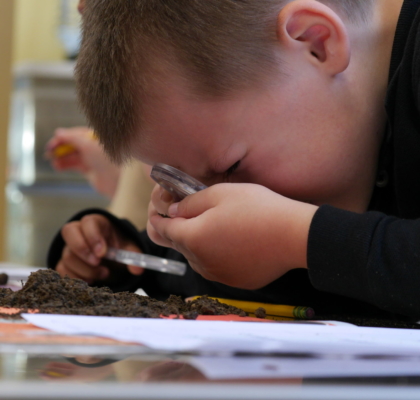These investigations are virtual adaptations of the FoodPrints Curriculum

Guessing Game: What Am I?
Investigation Description:
Welcome students and share that in today’s class we are going to learn about a tiny animal that is super important in the garden. You can generate excitement by playing a guessing game in which “worm” is the answer. Give time between each hint for students to think.
Share the following clues:
– It is alive
– It helps our gardens
– It is an animal
– It eats things that are rotten
– It is small
– It wiggles and builds tunnels
– It lives underground
– It does not have arms or legs
– It has a mouth, but no eyes, ears, or nose
– It likes the dark and quiet
If they haven’t figured it out after these clues, you can offer hints like, “It starts with w.” If they figure it out right away, still share the rest of the hints as additional information about worms.
If possible, show students a few live worms or screenshare images of worms. Share that worms do really important work for the garden and the planet: they eat bacteria on decaying plants, food, and even cardboard and paper. Everything that worms eat passes through their bodies and is turned into rich, fertile soil for growing plants! They also dig tunnels as they move around, and that helps water and air reach plant roots more easily so they can grow better.
Conclude by asking students to share one new thing they learned about worms and/or how worms are helpful in the garden.
Time: 10-15 minutes
Teacher Materials: Images of worms or live worms (optional)
Student Materials: None
This virtual investigation is adapted from: PK – Worms in the Garden

Make a Worm Model
Investigation Description:
Screenshare with students a clear, close-up photo of a worm. Discuss the different parts of the worm (and function of each, if you know it!) and remind students that while worms don’t have eyes or teeth or bones, they are still living creatures that do important work (decomposing dead matter!)
Here is a rundown on a few key worm parts, starting at the mouth end:
1. Mouth – food comes in through here
2. Crop – holds the food until it’s time to digest it
3. Gizzard – muscles, small grains of sand, and small stones in the gizzard grind up the food
4. Segments and bristles – a worm has no legs, but 8 bristles under each segment act like little legs that help the worm move
5. Anus – worm castings come out this end
Remember: worms do not have eyes or ears or legs!
Ask students to make their own worm diagram, labeling parts if they are able to. If supplies allow, encourage students to make a playdough model of a worm, being as detailed as possible.
Time: 10-15 minutes
Teacher Materials: Worm close-up photo, playdough, pencil/paper or whiteboard/markers to demonstrate worm diagramming
Student Materials: Paper and writing and drawing utensils; playdough (optional)
This virtual investigation is adapted from: PK – Worms in the Garden

Introduction to Soil
Investigation Description:
Welcome students to the FoodPrints classroom. Share that today’s lesson is about soil. To help students visualize soil, slowly cut away the peel of the apple and explain that the peel is like the soil of the earth. Since it is a thin covering, it is important to take good care of it. Explain that soil is the top layer of the earth where plants grow.
Then, show them a small cup of dirt and ask them to describe it using their senses (what does soil look like? what do they think it feels like/smells like, etc.)
Time: 10-15 minutes
Teacher Materials: Apple, sharp knife, cup/jar of soil
Student Materials: None
This virtual investigation is adapted from: Kindergarten – Exploring Soil

Act It Out: Impact of Weather on Plants
Investigation Description:
Have the students stand up and pretend they are a healthy plant on a nice sunny day. Have them show what their plant would do if there was a light breeze, and then what would happen if there was lots of wind and rain (they should dance or move their bodies around to show what they think would happen).
Next, ask students if they think the weather affects plants. Does weather affect the landscape in different areas? Do they think that plants play a role in the landscape and how it might change?
This should be considered a brainstorming session to get them thinking about how plants are an important part of the landscape. Next ask them what else might be affected by changing landscapes (people, animals, gardens).
Time: 5-10 Minutes
Teacher Materials: None
Student Materials: None
This virtual investigation is adapted from: 4th Grade – Root Systems & Erosion (this lesson will be on our website soon!)